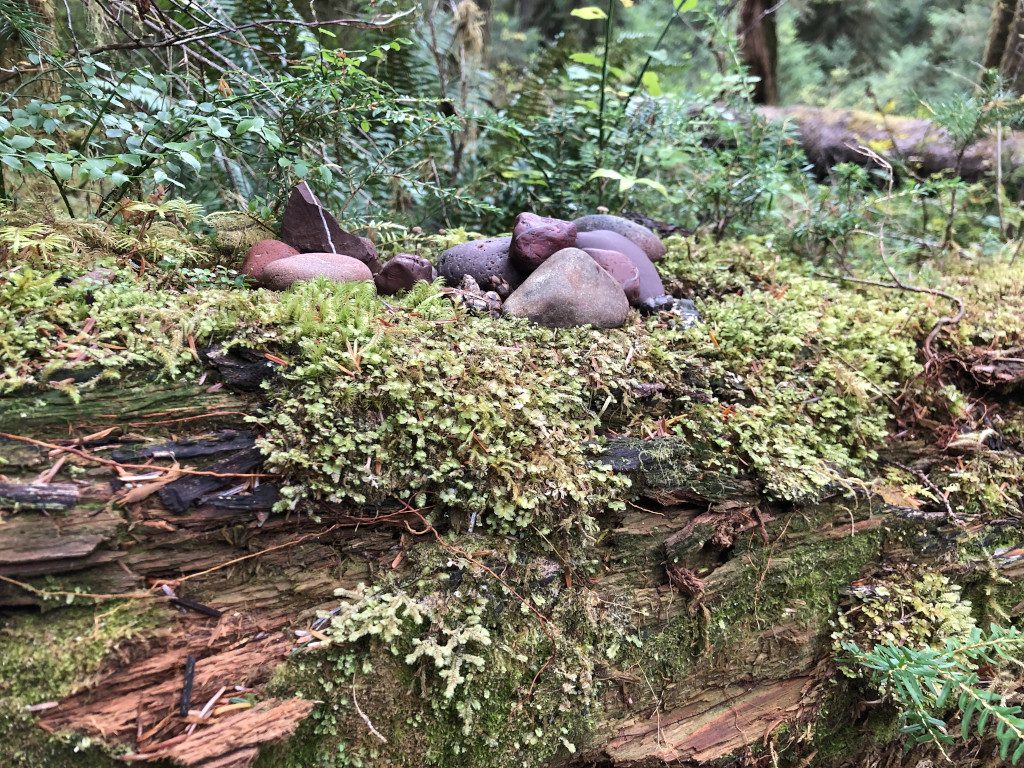With only a few days remaining until Election Day in the United States, things are likely to get really loud, as if they weren’t already loud enough. If you’re like me, occasionally you need to turn down the volume and embrace the silence. I’m hesitant to talk or write about silence since these very words interrupt it. And I’m hesitant to read about it for the same reason. That said, I do find inspiration from others who share an appreciation for it. For example:
- Pico Iyer’s Ted Talk
- The Joy of Quiet, Pico Iyer’s opinion piece in the New York Times
- The Art of Stillness, Pico Iyer’s book
- Zero Decibels: The Quest for Absolute Silence, George Michelsen Foy’s book
- One Square Inch of Silence, Gordon Hempton’s book
- One Square Inch, Gordon Hempton’s website
- Silence and the Presence of Everything, Krista Tippet’s interview with Gordon Hempton on her On Being podcast.
In One Square Inch of Silence, Gordon Hempton says “When we listen to silence, we hear not absence, but presence.” I believe this wholeheartedly. When we pause all the noise that we humans are constantly making, we discover a rich spectrum of natural sounds. They were there all along, but we couldn’t hear them. And when we finally hear them, it’s wonderful to stop and listen.
Hempton has traveled the world seeking silent places, and has identified a particular special silent spot in the Hoh Rainforest in Olympic National Park that he’s declared his “one square inch of silence.” If we can preserve the silence of that tiny spot, the effect will expand outward far beyond its center. And in this era of constant human noise, there’s a compelling need to preserve the few remaining silent places. On Earth Day 2005, Hempton placed a small red stone on a mossy log to mark his spot. In late September 2020, having grown increasingly weary of society’s crescendo, I shouldered my backpack and hiked solo into the Hoh Rainforest on a pilgrimage to find that one square inch.
It isn’t hard to find. Hempton’s website includes Directions to One Square Inch (in PDF), although the published coordinates seem to be a little off. I found it at N 47.86576°, W 123.87009° (link opens in Google Maps). There is not just one red stone, but several, evidence of others who have been on this same pilgrimage. The spot is surrounded by trees — Sitka Spruce, Western Red Cedar, Douglas Fir, Western Hemlock — in various stages of life and death. The landscape is blanketed in thick moss and ferns. I sit for a while, and listen. It is very still, but not silent. The Hoh River hums softly in the distance. Flies buzz by, and tiny birds flit in the surrounding trees. A distant crow calls. An elk bugles.

I take a decibel reading with my iPhone: 29 decibels average over five minutes, among my quietest readings in over three years of collecting data, though not the quietest (see below for my table of decibel readings for comparison).
I turn my attention to the Hoh River. Over the next few days I travel most of its length, from its origins at the Hoh Glacier on Mount Olympus to its terminus at the Pacific Ocean. I camp along the river bank, where historically the Hoh Tribe lived, fished, and foraged. For several days, I’m immersed in silence, which grows increasingly powerful. I take some additional decibel readings along the way, and capture a few moments from my journey on video.
I’ve taken some time over the last couple of weeks to fine-tune the video. All footage was captured on my iPhone, and the audio required some EQ finesse in order to filter out wind noise. I mixed the video in iMovie, and exported the audio track to Logic Pro where I adjusted volumes and EQ, then imported it back into iMovie. I also created an audio described version for people who are unable to see the video, taking care in the described version to find the right balance between being informative and respecting the silence. You can toggle between the described and non-described versions via the Description button on the media player. The media player is Able Player (it’s free, open source, and the most accessible media player on the planet).
I recommend watching the video with a good pair of headphones, and the audio cranked. Silence is best appreciated when it’s loud.
For the curious, I’ve provided below a sample of decibel readings I’ve taken over the last few years. Some of these are quiet places, others not so much, but it’s interesting to compare them.
Example Decibel Readings
| Avg | Max | Description |
|---|---|---|
| 28 | 30 | At Mazama Park on the southwestern flanks of Mount Baker, on a quiet afternoon in August. There is no breeze, and no sounds at all that I can appreciate. Total silence. |
| 29 | 33 | One Square Inch of Silence. See description above. Two modest spikes in volume occurred during moments when crow and elk broke silence. |
| 32 | 41 | Indoors in our rural home, windows closed, everyone sleeping. The ambient room sound includes a faint hum from appliances. |
| 35 | 42 | From a high point on my daily hike on Lookout Mountain, looking out across the Austin Creek valley. It’s a clear, calm day. The creek hums softly below, and insects buzz in a high frequency, barely audible. Occasionally a woodpecker drums a distant tree but it doesn’t register on my decibel meter. |
| 36 | 45 | On the back deck at 2pm in early July, surrounded by bird song and a gentle rusting of trees in the summer breeze. Peak readings are attained when humming birds buzz and squawk as they battle each other for a spot at my feeder. |
| 37 | 72 | Sitting on a bench in Boulevard park on the shore of Bellingham Bay. It’s a quiet morning with the water lapping gently against the banks. The morning southbound Amtrak line passes on the nearby track, briefly raising the average to around 40 (surprisingly quiet), but spiking to 72 dB when the train sounds its horn just after passing the park. |
| 40 | 52 | Bellingham Public Library, shortly after opening on a Saturday morning (pre-COVID). It’s generally quiet, but the air vent is directly overhead and emits a constant white noise. A single person is typing on a computer keyboard nearby, and a man is having a distant conversation with the lady at the help desk. All of the peak values are the result of that conversation. |
| 43 | 72 | On Holly Street in downtown Bellingham on a Sunday morning, in front of Wild Buffalo. What had been a quiet empty downtown, interrupted only by the cries of seagulls, has become a small city sprung to life. The ebb and flow of cars, trucks and motorcycles reverberates off the buildings on both side of the street. |
| 57 | 78 | Ski to Sea Parade in downtown Bellingham (pre-COVID). Although 78 dB was the loudest sound I had recorded at that time, overall the event didn’t seem to be terribly loud. There were, as expected, peaks as marching bands passed and fire engines sounded their sirens and horns. However, fire crews seemed to be intentionally respecting parade-goers’ hearing and keeping their noise theatrics to a minimum. All sirens and horns were recorded from a considerable distance. |
| 58 | 71 | Our washer, during its final spin cycle. |
| 60 | 72 | Inside the Thirsty Lion, at Union Station in Denver, a traditional annual stop while traveling to the Accessing Higher Ground conference in Westminster (pre-COVID). This particular night, the Broncos were playing the Patriots on Sunday Night Football and the orange-and-blue-clad crowd was rockin’. |
| 60 | 75 | Driving with windows open in the center lane on I-5 in downtown Seattle with concrete walls on either side of the freeway. It’s mid-afternoon and the traffic is heavy but moving at a good clip. The max reading is measured when a grumbling, belching pickup truck passes me on the left. |
| 70 | 84 | The mouth of the Hoh River as it meets the Pacific Ocean. The moment of this reading, on a stormy day in September 2020, is captured in the video. |
| 74 | 85 | Muncie Symphony concert outdoors on the lawn at Ball State University. The average is misleading as it varies dramatically throughout the concert, from 40 dB during quiet sections to the mid-eighties with the full orchestra playing fortissimo. The broad dynamic range of an orchestra is fantastic! (compare that with Macklemore, below) |
| 80 | 84 | Under the I-5 underpass in downtown Seattle, beneath the Convention Center. There’s a tent city here, occupied by dozens of homeless people, living among a constant roar. Sadly, many or most of the people living here probably now have significant hearing loss. |
| 95 | 100 | Macklemore concert at Key Arena in Seattle (December 22, 2017). The decibel readings grew consistently louder with each of the opening acts, and reached their peak during Macklemore’s performance. Interestingly, the maximum reading attained during the performance was 98 dB (no dynamics – a very flat, consistently loud volume). The spikes to 100 dB occurred between songs, via crowd noise alone. |
| 98 | 98 | Helicopter in Nepal Himalaya (April 13, 2018), a constant roar. All passengers were provided with a noise-canceling microphone headset. |
| 104 | 104 | My friend Mark Creamer in Colorado, operating his SKILSAW. Hearing protection is required. |
| N/A | 136.6 | Seattle Seahawks fans on a Sunday night game against the San Francisco 49ers (September 15, 2013, before COVID). Fans are provided with hearing protection upon entering the stadium. |
